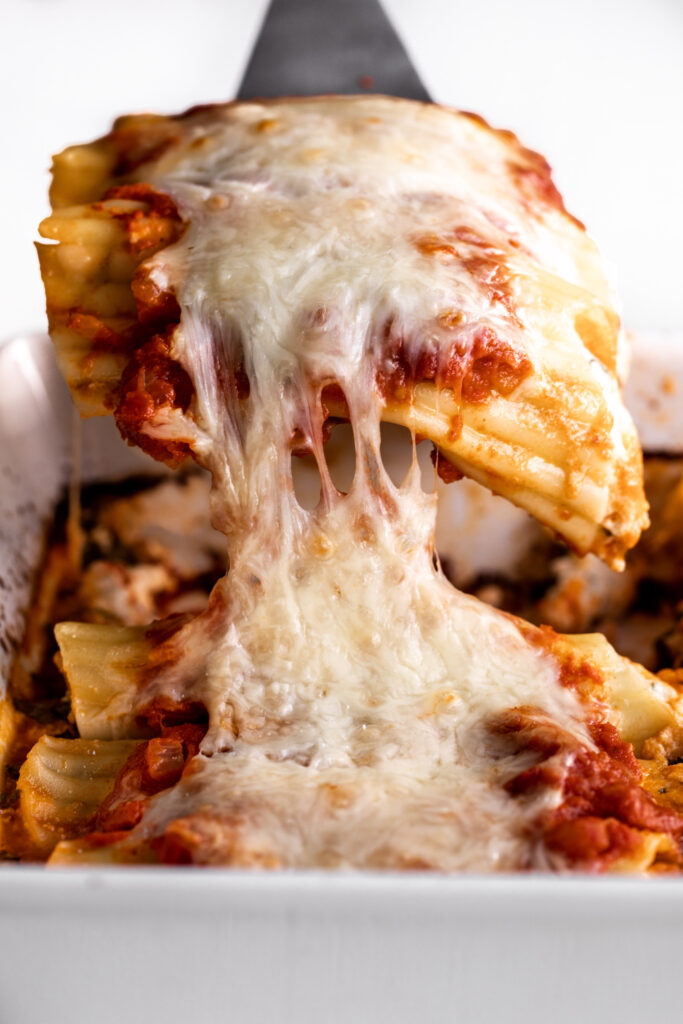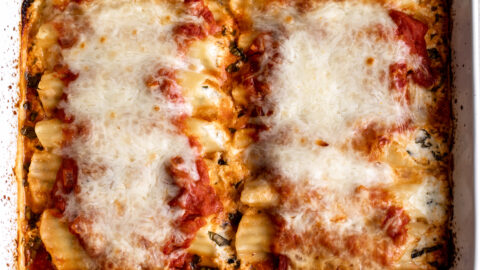It can even be prepared in advance and quickly popped into the oven on hectic weeknights. This pasta bake is stuffed with cheese and Italian herbs, covered in marinara sauce, and baked to perfection.
Long, broad, tubular pasta known as manicotti is typically cooked and filled with a ricotta cheese filling similar to the recipe for traditional stuffed shells.
One of the best comfort foods is baked cheese-stuffed manicotti, which is excellent for making in advance and eating on a busy weeknight.
Try it with cannelloni, large pasta shells, or even rigatoni. Since rigatoni are on the smaller side, allow yourself a little extra time because they require more preparation.
Replace the mozzarella with Monterrey Jack or a pepper jack cheese to add some extra heat. Or try cottage cheese in place of ricotta. To prevent the filling from being too watery, simply strain the cottage cheese before using it in the recipe.
Get creative with the filling. For a dish that stands out, try adding different types of cheese, spinach, herbs, or meat like chicken, beef, or sausage!
Grab a sizable freezer bag or pastry bag once the filling is ready to quickly and easily fill your manicotti shells!
How to Fill Manicotti Shells
To avoid breaks, I advise stuffing the manicotti with a long, narrow spoon. If possible, pipe the filling easily using a pastry bag with a large tip. It also works well to use a gallon resealable plastic bag with a small portion of the edge cut off.
If manicotti tubes are not available, I advise using sheets of lasagna instead. Using par-boiled lasagna noodles is a great, simple substitution if stuffing the tubes intimidates you. Simply spread the cheese filling on the pasta’s short edge, roll it up, and place it seam-side down in the pan. Cook the manicotti as directed below.
The ideal amount of cheese filling is between 3 tablespoons and 1/4 cup.
The manicotti can be stuffed and then placed in trays that can be frozen. When ready to serve, cover with sauce, seal, and store in the refrigerator or freezer. Simply increase the cooking time by about 20 minutes if you’re cooking the dish frozen, straight from the freezer rather than after it’s been thawed.
Italian sausage, whether mild or hot as long as it has Italian seasoning, is frequently used to fill manicotti. Cook one-half medium yellow onion in olive oil before browning one-half pound of meat and combining it with two cups of ricotta. Fill as directed below. Instead of tomato sauce, I prefer to serve rich, meat-stuffed manicotti with a vodka or blush sauce.
I like adding spinach, a popular variation, to the ricotta filling after sautéing leafy greens. Greens like kale or arugula can also be used. Plan on sautéing about 6 ounces of greens.

If you like this recipe for manicotti, I suggest looking at these:

Ingredients:
Do I Need to add the Greens?
No, if you prefer, you can substitute the greens for an additional cup (225g) of ricotta cheese and make these with just a cheese filling. Although my family occasionally substitutes curly endive or spinach for the escarole I used in this recipe, they are all delicious. Here is a link to my recipe for ricotta cheese and spinach stuffed shells with besciamella sauce as well. Please don’t substitute cottage cheese for the ricotta cheese.
Manicotti can be prepared, baked, and frozen in the pan (as long as it’s freezer- and oven-safe), without a doubt. They freeze perfectly. Additionally, before freezing, you can transfer them to smaller containers so you can use individual or two-person portions at a time, which makes for excellent make-ahead meals.
NB: Before covering the pasta with aluminum foil or closing the container, spread wax or parchment paper on top of it. Aluminum will be ingested if tomato sauce is used because it will “eat” into the foil.
FAQ
How do you stuff manicotti without breaking them?
How to Fill Shells Without Breaking Them. To avoid breaks, I advise stuffing the manicotti with a long, narrow spoon. If possible, pipe the filling easily using a pastry bag with a large tip. It also works well to use a gallon resealable plastic bag with a small portion of the edge cut off.
Is there a tool to stuff manicotti?
If you use my recipe, the manicotti shells won’t break because they aren’t boiled or softened before being stuffed. All you need is a small spoon; an espresso spoon would be ideal. Although a piping bag is an option, a spoon actually works just as quickly and creates less mess.
Does manicotti need to be cooked before stuffing?
How to Stuff Manicotti. You DO NOT need to cook the manicotti shells before baking this stuffed manicotti recipe. When the noodles are raw, it is simpler to stuff the manicotti without breaking it. Additionally, working with raw noodles is simpler than attempting to shape and fill limp, boiled noodles.
How do you make manicotti noodles?
- Add salt to taste and bring 4 to 6 quarts of water to a rolling boil.
- Add contents of package to boiling water.
- Boil for 7 minutes, stirring occasionally. Drain and cool on a sheet pan.
- Fill Manicotti according to desired recipe or back.
- Serve immediately with your favorite Barilla sauce.
